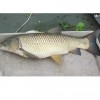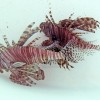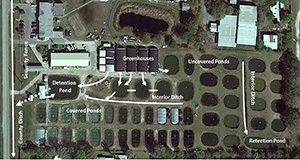Aquaculture is an important and diverse segment of the agricultural economy in Florida. Ornamental, live bait, food finfish, and other segments of this industry culture and trade in non-native species. Escape or release of these non-native cultured organisms is an environmental and legal concern in Florida and therefore a key consideration in aquaculture farm construction and operation. This 7-page fact sheet is the first in a four-part series devoted to educating industry and other stakeholders on the importance of preventing the escape of non-native species from aquaculture facilities as well as strategies for non-native species containment and regulatory compliance. Written by Quenton M. Tuckett, Carlos V. Martinez, Jared L. Ritch, Katelyn M. Lawson, and Jeffrey E. Hill and published by the School of Forest Resources and Conservation Program in Fisheries and Aquatic Sciences, it introduces the series, explains why non-native species containment is important, provides information on regulations, including the Florida Aquaculture Best Management Practices rule, describes the BMP inspection process, and provides advice on achieving compliance with these important regulations.
http://edis.ifas.ufl.edu/fa195
Tag: Jeffrey E. Hill
Preventing Escape of Non-Native Species from Aquaculture Facilities in Florida, Part 2: Facility Evaluation Strategies
Understanding how non-native species escape or are accidentally released helps producers better design and operate aquaculture facilities to reduce or prevent escape. Active management of critical points where escape is possible will help achieve regulatory compliance. This 6-page fact sheet written by Jeffrey E. Hill, Quenton M. Tuckett, Carlos V. Martinez, Jared L. Ritch, and Katelyn M. Lawson and published by the School of Forest Resources and Conservation Program in Fisheries and Aquatic Sciences is the second in a four-part series devoted to educating industry and other stakeholders on the importance of preventing the escape of non-native species from aquaculture facilities as well as strategies for non-native species containment and regulatory compliance. It describes farm layouts, explains how fish escape, and outlines a process that aquaculturists can complete to identify potential escape points on their farms.
http://edis.ifas.ufl.edu/fa196
Preventing Escape of Non-Native Species from Aquaculture Facilities in Florida, Part 3: Structural Strategies
Non-native species sometimes escape from aquaculture facilities, but producers can prevent these potentially harmful escapes by placing barriers like screens, covers, control structures, and ponds at vulnerable points. Aquaculture producers use these structures to prevent release of non-native species in compliance with Florida Aquaculture Best Management Practices. Further, many of the structures discussed in this 9-page fact sheet are also effective in addressing and maintaining compliance with the discharge requirements of those Best Management Practices. Written by Quenton M. Tuckett, Carlos V. Martinez, Jared L. Ritch, Katelyn M. Lawson, and Jeffrey E. Hill and published by the School of Forest Resources and Conservation, Program in Fisheries and Aquatic Sciences, the fact sheet provides escape prevention strategies and advice for building structures and barriers that can keep potentially harmful non-native species safely contained on aquaculture facilities.
edis.ifas.ufl.edu/fa197
Preventing Escape of Non-Native Species from Aquaculture Facilities in Florida, Part 4: Operational Strategies
Structural strategies to prevent the escape of non-native species from aquaculture facilities have numerous environmental benefits, and research at the UF/IFAS Tropical Aquaculture Laboratory has shown that structural strategies also reduce non-compliance with Florida Department of Agriculture and Consumer Services Best Management Practices. Operational and management strategies, however, are also very important. The strategies discussed in this 6-page fact sheet, the management of water, facilities, and employees, must not be overlooked. Operational strategies are easy, inexpensive, and, when used alongside structural strategies, highly effective, offering an impressive return on a minimal investment in the overall effort to minimize the escape of non-native species.
Written by Quenton M. Tuckett, Carlos V. Martinez, Jared L. Ritch, Katelyn M. Lawson, and Jeffrey E. Hill and published by the School of Forest Resources and Conservation, Program in Fisheries and Aquatic Sciences, this fact sheet is the fourth in a four-part series devoted to educating industry and other stakeholders on the importance of preventing escape of non-native species from aquaculture facilities as well as strategies for non-native species containment and regulatory compliance.
http://edis.ifas.ufl.edu/fa198
Grass Carp, the White Amur: Ctenopharyngodon idella Cuvier and Valenciennes (Actinopterygii: Cyprinidae: Squaliobarbinae)
 The grass carp, Ctenopharyngodon idella Cuvier and Valenciennes, was imported to the U.S. in 1963 as a biological control agent for hydrilla (Hydrilla verticilliata (L.f.) Royle) and other aquatic plants. Concerns of escape and reproduction, and the potential impacts that colonization of the fish could have on native flora and fauna led to research that developed a non-reproductive fish, which was equally effective in controlling hydrilla. In the warm waters of Florida, with abundant food, grass carp grow quickly at around 2 lbs/month or 0.91 kg/month and may achieve weights of 97 lbs (44 kg). Younger fish and female fish grow faster than older or male fish. Grass carp are the most effective biological control tool that has been identified for hydrilla. This 7-page fact sheet was written by Emma N.I. Weeks and Jeffrey E. Hill, and published by the UF Department of Entomology and Nematology, June 2014.
The grass carp, Ctenopharyngodon idella Cuvier and Valenciennes, was imported to the U.S. in 1963 as a biological control agent for hydrilla (Hydrilla verticilliata (L.f.) Royle) and other aquatic plants. Concerns of escape and reproduction, and the potential impacts that colonization of the fish could have on native flora and fauna led to research that developed a non-reproductive fish, which was equally effective in controlling hydrilla. In the warm waters of Florida, with abundant food, grass carp grow quickly at around 2 lbs/month or 0.91 kg/month and may achieve weights of 97 lbs (44 kg). Younger fish and female fish grow faster than older or male fish. Grass carp are the most effective biological control tool that has been identified for hydrilla. This 7-page fact sheet was written by Emma N.I. Weeks and Jeffrey E. Hill, and published by the UF Department of Entomology and Nematology, June 2014.
http://edis.ifas.ufl.edu/in1038
Invasive Species of Florida’s Coastal Waters: The Red Lionfish (Pterois volitans) and Devil Firefish (P. miles)
 Two species of Indo-Pacific lionfish (Pterois volitans and P. miles) are the first reported non-native marine fish to become established in the Atlantic Ocean. Genetic studies indicate that lionfish in the Atlantic are likely all descendants of a few individuals, consistent with the widely held belief that lionfish were introduced into the Atlantic as a result of accidental or deliberate release of aquarium pets. Regardless of the method of introduction, the prolific spread of these invasive species in the Atlantic Ocean ecosystem is cause for concern. This 5-page fact sheet was written by Maia McGuire and Jeffrey HIll, and published by the UF Department of Sea Grant, January 2013.
Two species of Indo-Pacific lionfish (Pterois volitans and P. miles) are the first reported non-native marine fish to become established in the Atlantic Ocean. Genetic studies indicate that lionfish in the Atlantic are likely all descendants of a few individuals, consistent with the widely held belief that lionfish were introduced into the Atlantic as a result of accidental or deliberate release of aquarium pets. Regardless of the method of introduction, the prolific spread of these invasive species in the Atlantic Ocean ecosystem is cause for concern. This 5-page fact sheet was written by Maia McGuire and Jeffrey HIll, and published by the UF Department of Sea Grant, January 2013.
http://edis.ifas.ufl.edu/sg132
BUL334/FA158 Stormwater Detention and Discharge from Aquaculture Ponds in Florida
Revised! Bulletin 334, a 10-page illustrated bulletin by A. G. Smajstrla, M. E. Griggs, A. M. Lazur, J. E. Hill, and C. L. Ohs, provides engineering information on the design, construction, and installation of a relatively inexpensive trickle-flow control device for management of stormwater discharge and water conservation. It also provides information on production pond freeboard requirements and size of detention pond required. Includes references. Published by the UF Program in Fisheries and Aquatic Sciences of the School of Forest Resources and Conservation, December 2008.
http://edis.ifas.ufl.edu/FA158



